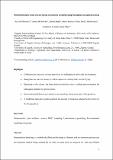Files in this item
Biomonitoring for wide area surveying in landmine detection using honeybees and optical sensing
Item metadata
| dc.contributor.author | Gillanders, Ross N. | |
| dc.contributor.author | Glackin, James ME. | |
| dc.contributor.author | Babić, Zdenka | |
| dc.contributor.author | Muštra, Mario | |
| dc.contributor.author | Simić, Mitar | |
| dc.contributor.author | Kezić, Nikola | |
| dc.contributor.author | Turnbull, Graham A. | |
| dc.contributor.author | Filipi, Janja | |
| dc.date.accessioned | 2022-01-18T00:38:29Z | |
| dc.date.available | 2022-01-18T00:38:29Z | |
| dc.date.issued | 2021-06 | |
| dc.identifier | 272707153 | |
| dc.identifier | 21a08d1c-fd52-45c1-93b6-8dc5682f878f | |
| dc.identifier | 85099612270 | |
| dc.identifier | 000641584000070 | |
| dc.identifier.citation | Gillanders , R N , Glackin , J ME , Babić , Z , Muštra , M , Simić , M , Kezić , N , Turnbull , G A & Filipi , J 2021 , ' Biomonitoring for wide area surveying in landmine detection using honeybees and optical sensing ' , Chemosphere , vol. 273 , 129646 . https://doi.org/10.1016/j.chemosphere.2021.129646 | en |
| dc.identifier.issn | 0045-6535 | |
| dc.identifier.other | RIS: urn:E864557F965E9E5D49EB1C95D645FC9A | |
| dc.identifier.other | ORCID: /0000-0002-8825-3234/work/88267791 | |
| dc.identifier.uri | https://hdl.handle.net/10023/24690 | |
| dc.description | This project has received funding from NATO Science for Peace & Security under grant agreement MYP G5355, and the Engineering and Physical Sciences Research Council under EP/K503940/1. | en |
| dc.description.abstract | Humanitarian demining is a worldwide effort and the range of climates and environments prevent any one detection method being suitable for all sites, so more tools are required for safe and efficient explosives sensing. Landmines emit a chemical flux over time, and honeybees can collect the trace residues of explosives (as particles or as vapour) on their body hairs. This capability was exploited using a passive method allowing the honeybees to freely forage in a mined area, where trace explosives present in the environment stuck to the honeybee body, which were subsequently transferred onto an adsorbent material for analysis by a fluorescent polymer sensor. Potential false positive sources were investigated, namely common bee pheromones, the anti-varroa pesticide Amitraz, and the environment around a clean apiary, and no significant response was found to any from the sensor. The mined site gave a substantial response in the optical sensor films, with quenching efficiencies of up to 38%. A model was adapted to estimate the mass of explosives returned to the colony, which may be useful for estimating the number of mines in a given area. | |
| dc.format.extent | 8 | |
| dc.format.extent | 1196220 | |
| dc.language.iso | eng | |
| dc.relation.ispartof | Chemosphere | en |
| dc.subject | Nitroaromatic | en |
| dc.subject | REST sampling | en |
| dc.subject | Luminescence quenching | en |
| dc.subject | Environmental modelling | en |
| dc.subject | Honeybee | en |
| dc.subject | GE Environmental Sciences | en |
| dc.subject | QC Physics | en |
| dc.subject | QD Chemistry | en |
| dc.subject | DAS | en |
| dc.subject | AC | en |
| dc.subject.lcc | GE | en |
| dc.subject.lcc | QC | en |
| dc.subject.lcc | QD | en |
| dc.title | Biomonitoring for wide area surveying in landmine detection using honeybees and optical sensing | en |
| dc.type | Journal article | en |
| dc.contributor.sponsor | EPSRC | en |
| dc.contributor.sponsor | NATO | en |
| dc.contributor.institution | University of St Andrews. School of Physics and Astronomy | en |
| dc.contributor.institution | University of St Andrews. Sir James Mackenzie Institute for Early Diagnosis | en |
| dc.contributor.institution | University of St Andrews. Centre for Biophotonics | en |
| dc.identifier.doi | 10.1016/j.chemosphere.2021.129646 | |
| dc.description.status | Peer reviewed | en |
| dc.date.embargoedUntil | 2022-01-18 | |
| dc.identifier.grantnumber | N/A | en |
| dc.identifier.grantnumber | MYP G5355 | en |
This item appears in the following Collection(s)
Items in the St Andrews Research Repository are protected by copyright, with all rights reserved, unless otherwise indicated.

